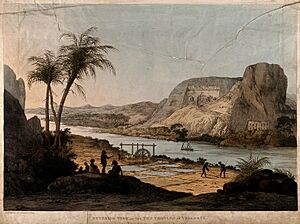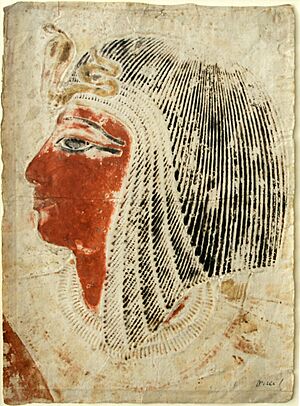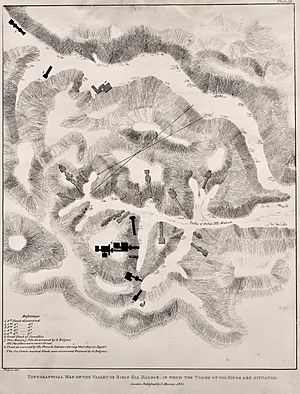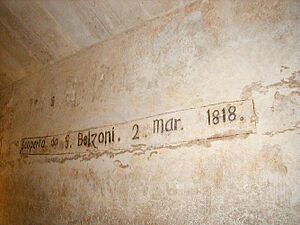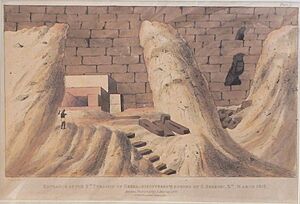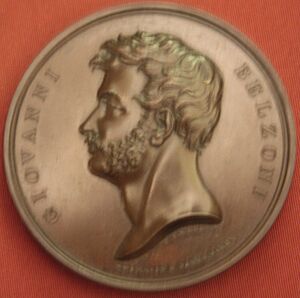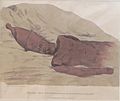Giovanni Battista Belzoni facts for kids
Quick facts for kids
Giovanni Battista Belzoni
|
|
|---|---|

Giovanni Battista Belzoni
|
|
| Born | 5 November 1778 |
| Died | 3 December 1823 (aged 45) |
| Nationality | Italian |
| Known for | Egyptian antiquities |
| Spouse(s) | Sarah Banne |
Giovanni Battista Belzoni (born November 5, 1778 – died December 3, 1823) was an amazing Italian explorer and one of the first archaeologists to study ancient Egypt. He was sometimes called "The Great Belzoni" because of his many important discoveries. He helped bring many ancient Egyptian treasures to light. These included a huge seven-tonne statue of Pharaoh Ramesses II and the tomb of Pharaoh Seti I. He was also the first person in modern times to enter the second-largest pyramid at Giza.
Contents
Giovanni Belzoni: The Giant Explorer
Giovanni Battista Belzoni was born in Padua, Italy. He was a very tall and strong man, standing at 6 feet 7 inches (about 2 meters) tall. Before he became an explorer, he worked in a circus in England. There, he performed as a strongman, showing off his amazing strength. He also had an interest in engineering and water systems.
Adventures in Egypt
Belzoni's life changed when he traveled to Egypt in 1815. He initially went there to sell a water-lifting machine he had invented. However, he soon became fascinated by the ancient ruins and monuments. He started working for Henry Salt, the British Consul-General in Egypt. Salt hired Belzoni to collect ancient Egyptian artifacts for the British Museum in London.
Amazing Discoveries
Belzoni was known for his daring and often difficult expeditions. He explored many important sites in Egypt, making several famous discoveries.
Moving the Younger Memnon
One of Belzoni's most famous achievements was moving the huge head of a statue known as the "Younger Memnon". This seven-tonne (about 7,000 kg) bust belonged to Pharaoh Ramesses II. It was located at the Ramesseum in Thebes. Moving such a massive stone object was a huge challenge. Belzoni used ropes, levers, and wooden rollers to transport it over 100 miles to the Nile River. From there, it was shipped to England and is now a famous exhibit at the British Museum.
Clearing Abu Simbel
Belzoni also helped clear the sand from the entrance of the Great Temple at Abu Simbel. This temple, carved into a rock cliff, was mostly buried by sand. Belzoni's team worked hard to uncover the massive statues guarding its entrance. This allowed people to enter and explore the temple's amazing interior.
The Tomb of Seti I
In 1817, Belzoni made one of his most important discoveries: the tomb of Pharaoh Seti I in the Valley of the Kings. This tomb, now known as KV17, is sometimes called "Belzoni's Tomb" because of his discovery. It was incredibly well-preserved, with colorful paintings and hieroglyphs on its walls. Inside, he found the beautiful sarcophagus of Seti I, which was later brought to England.
Inside the Pyramid of Khafre
In 1818, Belzoni became the first person in modern times to find the original entrance and enter the Pyramid of Khafre. This is the second-largest pyramid at the Giza complex. He found an inscription inside that showed he was the first to enter it in many centuries.
Belzoni's Legacy
Giovanni Belzoni's work helped to start the field of Egyptology. He was one of the first to carefully record what he found, even though archaeological methods were still new. His discoveries brought many ancient Egyptian treasures to the world's attention. He also wrote a book about his travels and discoveries, which became very popular.
His Final Journey
Belzoni died in 1823 while on another expedition in West Africa, in what is now Nigeria. He was trying to find the source of the Niger River. He was only 45 years old. His adventurous spirit and important contributions to understanding ancient Egypt are still remembered today.
Images for kids
See also
 In Spanish: Giovanni Battista Belzoni para niños
In Spanish: Giovanni Battista Belzoni para niños




